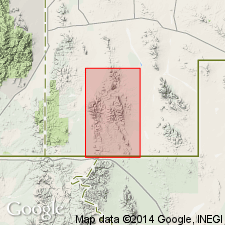
- Usage in publication:
-
- U-Bar Formation
- Modifications:
-
- Areal extent
- AAPG geologic province:
-
- Pedregosa basin
Summary:
Extended within Pedregosa basin to southern Animas Mountains, Hidalgo Co, NM in Pedregosa basin. Is of Early Cretaceous age.
Source: GNU records (USGS DDS-6; Denver GNULEX).
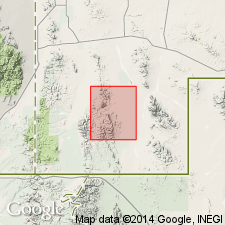
- Usage in publication:
-
- U-Bar Formation
- Modifications:
-
- Overview
- AAPG geologic province:
-
- Pedregosa basin
Summary:
Best exposed between Gillespie and Bennett Creeks, Hidalgo Co, NM in Pedregosa basin. Lies between Hell-to-Finish Formation (below) and Mojado Formation (above). Both contacts conformable. Section 1,742 ft thick measured along Gillespie Creek in sec 34, T30S, R18W and secs 3, 4, 9, and 10, T31S, R18W. Contains a variety of fossils (oysters, pectens, rudistids, gastropods, corals, echinoids, and forams). Some fossil wood. Of Early Cretaceous age. Geologic map.
Source: GNU records (USGS DDS-6; Denver GNULEX).
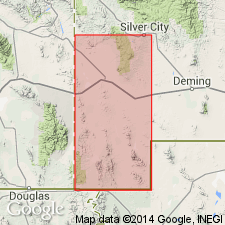
- Usage in publication:
-
- U-Bar Formation
- Modifications:
-
- Named
- Reference
- AAPG geologic province:
-
- Pedregosa basin
Summary:
Named for exposures on U-Bar Ridge off the southwest flank of the Big Hatchet Mountains. A composite type section is measured with lower part in sec 6, T32S, R15W, and the upper part in sec 21, T32S, R15W, Hidalgo Co, NM, Pedregosa basin. Is made up of 5 informal members (ascending): brown limestone, oyster limestone, limestone-shale, reef limestone, and suprareef limestone. Reference section designated at Little Hat Top, sec 19, T32S, R14W for lower part and at Pierce Tank, secs 29 and 30, T32S, R14W for oyster limestone and limestone shale members. Limestone may be dark gray to black, coarse grained to finely crystalline, or lithographic. Shale may be light to dark gray and calcareous. Thickness about 3,500 ft. Assigned an Aptian to early and possibly middle Albian age on basis of abundant fossils (nautiloids, forams, ammonites, pelecypods, gastropods, corals). Conformably overlies Hell-to-Finish Formation (new) and conformably overlain by Mojado Formation (new).
Source: GNU records (USGS DDS-6; Denver GNULEX).
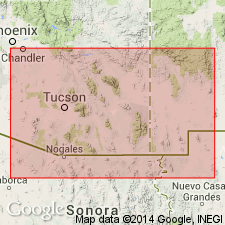
- Usage in publication:
-
- U-Bar Formation*
- Modifications:
-
- Overview
- AAPG geologic province:
-
- Pedregosa basin
Summary:
Is formation in Big Hatchet and Animas Mountains, Hidalgo Co, NM in Pedregosa basin. Overlies Hell-to-Finish Formation (Neocomian and Aptian) of Zeller, Jr. (1965). Underlies Mojado Formation (Albian and early Cenomanian) of Zeller, Jr. (1965). Is about 3,500 ft thick in Big Hatchet Mountains; only about one-half as thick in Animas Mountains. Upper few hundred ft yields rich fauna of marine mollusks and ORBITOLINA and is considered to be of Aptian and Albian age. Upper part is correlated with upper member of Mural Limestone and lower several thousand ft considered equivalent to most of Morita Formation and lower member of Mural Limestone of Mule Mountains. [See fig. 5 for regional correlations.] Age is Aptian and Albian (Early Cretaceous).
Source: GNU records (USGS DDS-6; Denver GNULEX).
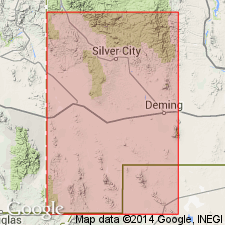
- Usage in publication:
-
- U-Bar Formation
- Modifications:
-
- Areal extent
- AAPG geologic province:
-
- Pedregosa basin
- Basin-and-Range province
Summary:
Extended to Little Hatchet Mountains, Pedregosa basin and Basin-and-Range province, to replace much of the Howells Ridge Formation [an excellent thing to do]. Is conformable with underlying Hell-to-Finish and overlying Mojado Formations. Is a marine unit about 4,000 ft thick divisible into (ascending): brown limestone member, oyster limestone member, limestone-shale member, reef limestone member, and suprareef limestone member. Correlates with Lowell and Mural Formations of southeast AZ. Formerly (Lasky, 1947) mapped as part of Howell's Ridge Formation in Little Hatchet Mountains. Geologic map. Cross sections. Of Early Cretaceous age.
Source: GNU records (USGS DDS-6; Denver GNULEX).
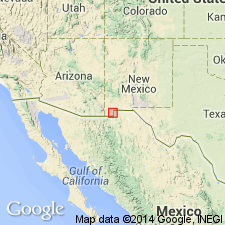
- Usage in publication:
-
- U-Bar Formation*
- Modifications:
-
- Overview
- AAPG geologic province:
-
- Pedregosa basin
Summary:
Used in Big Hatchet Mountains, Hidalgo Co, NM, Pedregosa basin, as described by Zeller (1965). Is present, though thin, on the east flank of the Animas Mountains, west of the Big Hatchets. Is the erosional remnant of a resistant limestone reef folded into a broad syncline. At Sierra Rica only the upper part is exposed. In the central Animas Mountains is thinner than at type. Marine invertebrates indicate an early to middle Albian age, or Early Cretaceous age.
Source: GNU records (USGS DDS-6; Denver GNULEX).
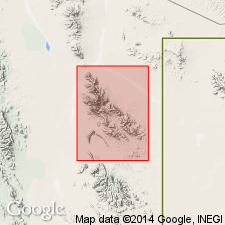
- Usage in publication:
-
- U-Bar Formation*
- Modifications:
-
- Mapped 1:24k
- Dominant lithology:
-
- Limestone
- Shale
- AAPG geologic province:
-
- Pedregosa basin
Summary:
U-Bar Formation of Bisbee Group. Mapped in Big Hatchet Mountains, Hidalgo County, southwestern New Mexico. Upper member: light-gray limestone made up mainly of a 200+ feet (60+ m) thick biohermal reef, contains coral and algal-mat fossils and, usually high in unit, rudistid mollusks and ORBITOLINA foraminfera; thickness about 500 feet (150 m); includes sub-reef and supra-reef limestone of Zeller (1965). Lower member (shale unit): pale-yellowish-brown shale and siltstone with sparse, thin interbedded sandstone and limestone, about 500 feet (140 m) thick. Lower member (limestone unit): pale-yellowish-brown shale, siltstone, limestone, and in lower part some sandstone; fossiliferous (EXOGYRA oyster shells, and pelecypod and silicified wood fragments); thickness about 2,500 feet (750 m), includes oyster limestone and brown limestone of Zeller (1965); Zeller's gypsum beds were not located by Drewes or D.C. Scott (Drewes and others, 1988). Above Hell-to-Finish Formation and below Mojado Formation, both of Bisbee Group. Age is Early Cretaceous.
Source: Publication.
For more information, please contact Nancy Stamm, Geologic Names Committee Secretary.
Asterisk (*) indicates published by U.S. Geological Survey authors.
"No current usage" (†) implies that a name has been abandoned or has fallen into disuse. Former usage and, if known, replacement name given in parentheses ( ).
Slash (/) indicates name conflicts with nomenclatural guidelines (CSN, 1933; ACSN, 1961, 1970; NACSN, 1983, 2005, 2021). May be explained within brackets ([ ]).

